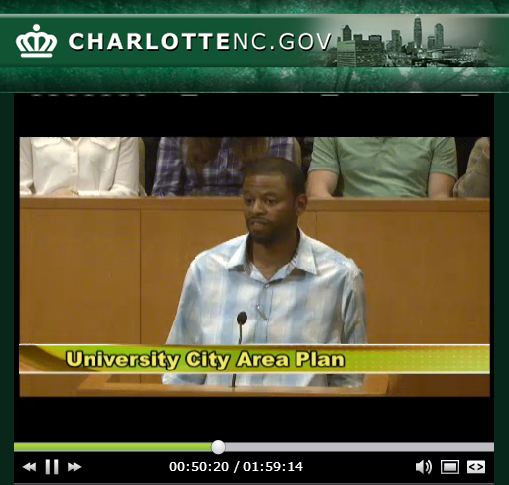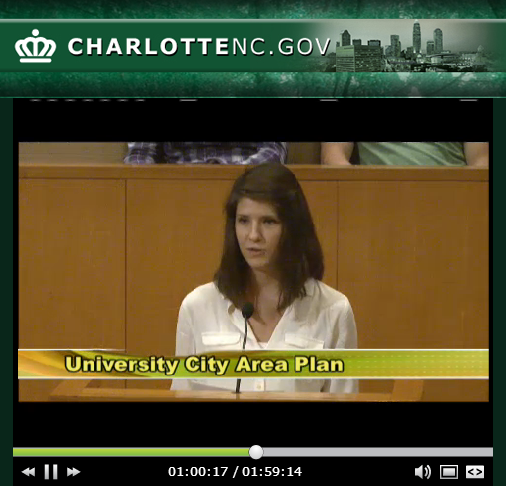200+ residents sign petition for a walkable University City area
At Monday evening’s public comment period to Charlotte City Council on the University City Area Plan (UCAP), Sustain Charlotte announced that over 200 residents had signed our petition. The petition asks Council to approve the UCAP, but also add corrective rezoning to transit-oriented development (TOD) within 1/4 mile of Blue Line Extension (BLE) stations in University City. We hand delivered our petition with 194 signatures to City Council, Mayor Clodfelter and the City Manager during the 7:00 meeting, but we were thrilled to see that the number of signatures exceeded 200 just before we addressed Council! For more background on the UCAP and our involvement in it, check out our recent blog post. 15 residents registered to speak on this issue.

Wil Russell addressed City Council to ask for transit-oriented development.
Wil Russell, a resident of University City and board member of Sustain Charlotte, urged City Council to adopt the University City Area Plan, but require transit-oriented development. He said, “Transit-oriented development will provide more opportunities to live and work near a mode of transit, which encourages ridership and sparks more economic development.” Russell acknowledged that building a more walkable University City will not be easy, but needs to be done to improve quality of life and fully leverage our investment in the Blue Line Extension. He said, “The challenge that this Council should accept is to fight. Fight for the University City area and fight for transit-oriented development. Be willing to accept mixed use development, pedestrian-friendly infrastucture, more efficient land use and fewer surface parking lots, as we’ve seen in South End.”
Russell urged Council to “fire up the engines of creativity to propel us to a vision of a safe, efficient, and vibrant land use plan.” Watch his full testimony (begins at 50 minutes 01 seconds). You’ll need to first scroll down and then click on the word ‘video’ for the April 13 meeting under ‘Archived Meetings’. When the video window opens, grab the gray circle with your mouse/point and move it horizontally to 50 minutes 01 seconds.
Branyn Calegar, Sustain Charlotte’s Communications + Development Director, spoke about the difficulties she experienced when she moved to University City after living in Boone: “Boone was a place where I walked everywhere and felt a true sense of place. That being said, I was almost shocked when I moved to the University City Area where it was very difficult and dangerous to walk or bike anywhere. I was completely reliant on my car, even to go less than a mile to the nearest grocery store or the university campus. Living in a place that was so physically disconnected was difficult for me, not only because it was lacking a sense of vibrancy and place, but also because I knew that this was not a sustainable way to live.”
Calegar contrasted this with her more recent experience of living in a more walkable, people-oriented community: “As of a couple months ago, I am now living in South End, and working for Sustain Charlotte in Uptown. I live and work in a place where I can conveniently and safely walk, bike and ride the light rail. So I support transit-oriented development, or TOD, because of my first-hand knowledge and experience of its success as a tool for creating vibrant, livable places.”
Watch Calegar’s full comments (begins at 59 minutes 59 seconds).

Branyn Calegar found University City Area lacking in walkability and a sense of place.
Martin Zimmerman, a member of the Transportation Choices Alliance coordinated by Sustain Charlotte (although not speaking on behalf of the alliance’s members) urged City Council to adopt corrective rezonings as a tool to make sure the vision of the UCAP is achieved. He said, “TS (Transit Supportive) zoning is not robust enough. It allows the continuation of sprawl-centric uses on North Tryon and elsewhere throughout the UCAP. It’s all clearly spelled out in the City of Charlotte zoning code. Among other drawbacks, TS zoning might also postpone Town Center levels of dense, mixed-use urban development for the JW Clay / University Place properties for decades. TOD zoning could avoid such delays.”
Zimmerman further stressed the need to leverage the city’s investment in light rail by adequately supporting appropriate development: “Taxpayers have invested $1.2 billion into the BLE light rail. City Council needs to match that transportation commitment with a land-use commitment. City Council needs to assure in land-use terms that the core of UCity is transformed from auto-dependent, unsustainable sprawl to an urban environment.”
Zimmerman’s comments can be viewed at 39 minutes 51 seconds.
Eric Zaverl, a neighborhood leader in South End and member of the Transportation Choices Alliance (again, not speaking officially on its behalf) asked City Council to complete two homework assignments. First, he asked them to type in South End’s zip code of 28203 at WalkScore. Even eight years after the Blue Line began running and despite considerable growth in mixed use development, South End is still a work in progress. Its Walk Score of 66, or “Somewhat Walkable” means that only certain daily tasks can be done on foot or by bike. Second, Zaverl asked Council to read through the station area plans for South End and New Bern. “Better yet, take a little road trip and go down to those neighborhoods and look at everything that was supposed to be recommended. You’re not going to see all of it there. There’s not much “teeth” to that plan. It’s going to be 10 years since that was adopted and there’s still a lot left…I’m just pushing you to get it right because you have one chance. Zaverl’s comments ended on a light note as Mayor Dan Clodfelter dubbed him “The Ghost of TOD Past”. Zaverl’s comments begin at 1 hour 15 minutes 40 seconds.
To view the complete video of Charlotte area residents speaking to Council about this issue, you’ll need to first scroll down and click on the word ‘video’ for the April 13 meeting under ‘Archived Meetings’. When the video window opens, grab the gray circle with your mouse/point and move it horizontally to 50 minutes 01 seconds. To view the public comment period including the presentation by Planning Department staff, start watching at 24 minutes 46 seconds.
City Council’s Transportation and Planning Committee will meet next Thursday, April 23 to further discuss the UCAP. Let’s let them know by then how much we value a walkable, people-oriented future for University City. If you would like to help, here are a few simple steps:
1. Sign our petition asking City Council to adopt the UCAP but also implement corrective rezonings. Then, share it with your contacts in the Charlotte area. Tell them why you signed and invite them to sign.
2. Send your comments about the plan to [email protected] and the 5 members of City Council on the Transportation and Planning Committee: Vi Lyles ([email protected]), David Howard ([email protected]), Patsy Kinsey ([email protected]), Greg Phipps ([email protected]), and Kenny Smith ([email protected]). You can also write to the entire Council. Click here for their contact information.
3. Attend the City Council Transportation and Planning Committee meeting at 12:00pm on Thursday, April 23 in Room 280 of the Charlotte Mecklenburg Government Center, 600 E. 4th St, Charlotte. Planning Department staff will present a summary of public comments and present staff proposed revisions to the Committee for consideration. Following a recommendation from Transportation and Planning Committee, the plan will be referred to City Council to be considered for adoption (meeting date to be determined). This meeting is open to the public. However, it is not a public comment period and you will not be able to directly address Council.
You don’t need to read the entire University City Area Plan in order to comment! It’s important for City Council and staff to hear from residents throughout the Charlotte area who will benefit from a more walkable, people-oriented University City. Share your stories of how you plan to use the LYNX Blue Line Extension to connect to school, a job, medical facilities, or visits with family and friends. If you live or spend time in the area, talk about what problems you currently experience and how they could be improved with better land use.
Thanks for reading!
As a nonprofit, community support is essential for us to keep doing what we do — including providing free articles like this. If you found this article helpful, please consider supporting Sustain Charlotte.
Want to stay in the loop? Subscribe to our weekly newsletter and follow us on Instagram, Facebook, and Twitter.
